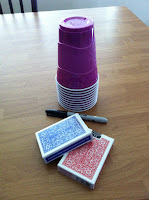Have you ever wondered what you could possibly do with all those left over containers. Of course you can recycle them which is always a great thing, but before recycling, you can give them to your little one for a great educational experience. This activity is so simple that it takes little effort to put together.
For this activity, the only items you will need are a variety of plastic containers with their corresponding lids. So easy!
While playing with the lids and containers, children will develop:
For this activity, the only items you will need are a variety of plastic containers with their corresponding lids. So easy!
While playing with the lids and containers, children will develop:
- Fine motor skills through manipulating the containers and lids
- Eye-hand coordination
- Size differentiation - small, medium, large
- Sorting
- Shapes - cylinders, cubes, ovals, circles (this all depends on what kind of containers you have)
To play, all you need to do is lay out the lids and containers side by side and let your youngster explore and investigate the different sizes of containers. If your child is a little younger, feel free to give them a little push and show them that the lids go on top of the containers. I bet they'll enjoy doing this activity and it might keep them busy for a some time so you might be able to get some stuff done as well! :-)
Have fun!



.JPG)






